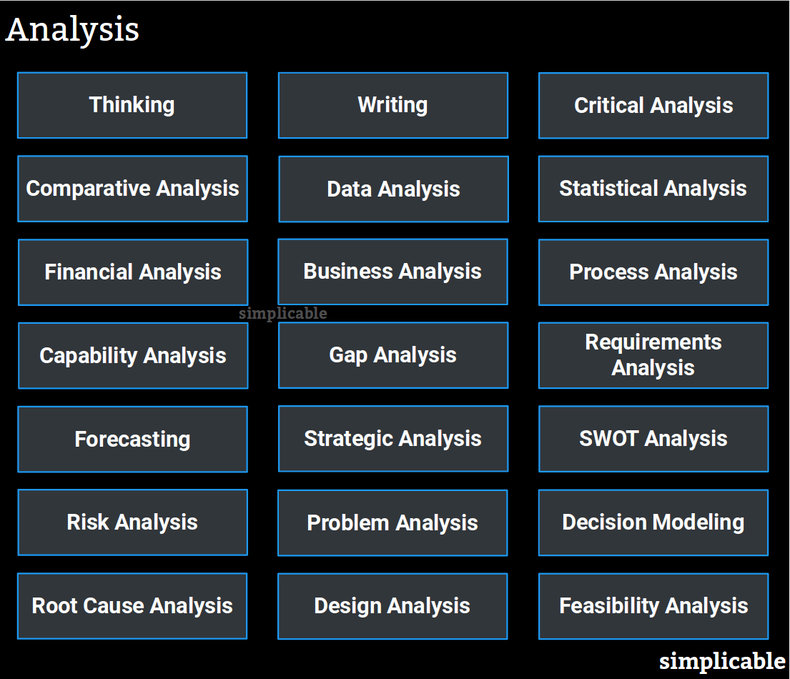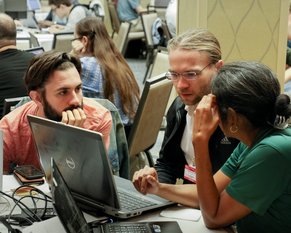
Thinking
Analysis is the process of identifying concepts that capture the characteristics of something and using these concepts to develop meaning.A consumer buying socks considers factors such as color, style, material, size, brand reputation and price. These concepts are used to break down each available product to quickly understand if it matches the consumer's needs.
Writing
Analysis in writing is the process of composing an opinion or objective assessment by breaking things into their elements.A film reviewer develops an opinion about a film based on elements such as characters, performance, plot, conflict, resolution, structure, theme, scenes, dialog and production value.
Critical Analysis
Critical analysis is the practice of evaluating something.A student evaluates the urban design of a neighborhood by evaluating factors such as environment, community, safety, efficiency and cost-effectiveness.
Comparative Analysis
Comparative analysis is the process of comparing and contrasting things using their common elements.A student compares the urban design of a city with very high quality of life with a city that has very low quality of life despite similar income levels.
Data Analysis
Data analysis is the systematic evaluation of data.A telecom company performs a data analysis to find and correct data quality issues that caused customers to be overcharged for services.
Statistical Analysis
Statistical analysis is the practice of collecting, processing, organizing, interpreting and presenting numerical data.A researcher integrates several data sets to investigate if there is any correlation between cancer rates and living or working in close proximity to farms that use a particular agricultural chemical.
Financial Analysis
Any analysis involving money or investments.A building company performs a return on investment analysis for a proposed resort condominium project.
Business Analysis
Business analysis is the broad practice of developing knowledge in an organizational setting.A business analyst develops requirements, measures things, solves problems in order to achieve organizational objectives.
Process Analysis
Business process analysis is the process of modeling, measuring and improving processes.A hotel manager documents and measures the steps that are followed to fulfill customer requests to determine if there is an opportunity to improve productivity and customer satisfaction.
Capability Analysis
Evaluating the capabilities of an organization or team and planning to add or improve capabilities.An IT department performs a risk management capability analysis to identify what risks are being managed and what risks are effectively unmanaged.
Gap Analysis
A gap analysis is a comparison of where you are and where you want to be.A construction site manager identifies hazards in the workplace to identify gaps in a firm's safety policies and practices. This can be viewed as a gap between current safety risks and the firm's stated policy of minimizing safety risk.
Requirements Analysis
Requirements analysis is the process of identifying needs and developing specifications for change.A business analyst collects requirements for a system from five business units. These have little cohesion or value as a set so the analyst works to refine, prioritize and resolve until the requirements have some semblance of value.
Forecasting
Developing estimates of the future.A clothing manufacturer develops seasonal forecasts of demand by product category in order to plan production, distribution and marketing.
Strategic Analysis
Evaluating plans to achieve goals in an environment of constraint and competition.A technology company performs an analysis of its strategic options after a larger competitor launches a new product that threats to take a great deal of its market share.
SWOT Analysis
A popular type of analysis that involves listing your strengths, weaknesses, opportunities and threats. This is applied to a competitive situation such as a career or business.A small business lists its strengths, weaknesses, opportunities and threats as part of its annual strategic planning efforts.
Risk Analysis
The process of identifying risks and evaluating impact, probability and treatment options.A resort hotel develops a list of risks to their business and creates a risk management plan that reduces risk exposure by $350,000.
Problem Analysis
Investigating problems and modeling potential solutions.A food manufacturer investigates quality control issues that cause products to have variable composition that differs from the claims made on the product label.
Decision Modeling
Developing a framework for making a decision including elements such as process and parameters.A bank develops a mandatory decision process for large commercial credit deals that requires analysis of risk and payback to meet certain thresholds.
Root Cause Analysis
Determining the root cause of problems.A company uses root cause analysis techniques such as 5 whys to uncover the deep organizational issues that caused executive compensation to be underreported for more than a decade.
Design Analysis
Design analysis is the process of questioning, challenging and reinventing design.A designer engages with actual users of a product in the field to determine elements of the customer experience that are failing.
Feasibility Analysis
A feasibility analysis is the process of determining if something is possible and realistic.An urban planner performs an analysis to determine if a proposal for a living street is legally, politically and technically feasible.
| Overview: Analysis Examples | ||
Type | ||
Definition | The practice of breaking things into their component elements in order to understand them. | |
Related Concepts | ||








































